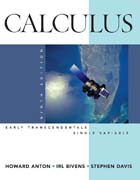
The ninth edition continues to provide engineers with an accessible resource for learning calculus. The book includes carefully worked examples and specialproblem types that help improve comprehension. New applied exercises demonstrate the usefulness of the mathematics. Additional summary tables with step-by-step details are also incorporated into the chapters to make the concepts easier to understand. The Quick Check and Focus on Concepts exercises have been updated as well. Engineers become engaged in the material because of the easy-to-read style and real-world examples. INDICE: Chapter 0 Before Calculus 0.1 Functions 0.2 New Functions from Old0.4 Families of Functions 0.5 Inverse Functions; Inverse Trigonometric Functions 0.6 Exponential and Logarithmic Functions Chapter 1 Limits and Continuity 1.1 Limits (An Intuitive Approach) 1.2 Computing Limits 1.3 Limits at Infinity; End Behavior of a Function 1.4 Limits (Discussed More Rigorously) 1.5 Continuity 1.6 Continuity of Trigonometric, Exponential, and Inverse Functions Chapter 2 The Derivative 2.1 Tangent Lines and Rates of Change 2.2 The Derivative Function 2.3 Introduction to Techniques of Differentiation 2.4 The Product and Quotient Rules 2.5 Derivatives of Trigonometric Functions 2.6 The Chain Rule Chapter 3 Topics in Differentiation 3.1 Implicit Differentiation 3.2 Derivatives of Logarithmic Functions 3.3 Derivatives of Exponential and Inverse Trigonometric Functions 3.4 Related Rates 3.5 Local Linear Approximation; Differentials 3.6 L'Hôpital's Rule; Indeterminate Forms Chapter 4 The Derivative in Graphing and Applications 4.1 Analysis of Functions I: Increase, Decrease, and Concavity 4.2 Analysis of Functions II: Relative Extrema; Graphing Polynomials 4.3 Analysis of Functions III: Rational Functions, Cusps, and Vertical Tangents 4.4 Absolute Maxima and Minima 4.5 Applied Maximum and Minimum Problems 4.6 Rectilinear Motion 4.7 Newton's Method 4.8 Rolle's Theorem; Mean-Value Theorem Chapter 5 Integration 5.1 An Overview of the Area Problem 5.2 The Indefinite Integral 5.3 Integration by Substitution 5.4 The Definition of Area as a Limit; Sigma Notation 5.5 The Definite Integral 5.6 The Fundamental Theorem of Calculus5.7 Rectilinear Motion Revisited Using Integration 5.8 Average Value of a Function and its Applications 5.9 Evaluating Definite Integrals by Substitution 5.10 Logarithmic and Other Functions Defined by Integrals Chapter 6 Applications of the Definite Integral in Geometry, Science, and Engineering 6.1 Area Between Two Curves 6.2 Volumes by Slicing; Disks and Washers 6.3 Volumes by Cylindrical Shells 6.4 Length of a Plane Curve 6.5 Area of a Surface of Revolution 6.6 Work 6.7 Moments, Centers of Gravity, and Centroids 6.8 Fluid Pressure and Force 6.9 Hyperbolic Functions and Hanging Cables Ch 7 Principles of Integral Evaluation 7.1 An Overview of Integration Methods 7.2 Integration by Parts 7.3Integrating Trigonometric Functions 7.4 Trigonometric Substitutions 7.5 Integrating Rational Functions by Partial Fractions 7.6 Using Computer Algebra Systems and Tables of Integrals 7.7 Numerical Integration; Simpson's Rule 7.8 Improper Integrals Ch 8 Mathematical Modeling with Differential Equations 8.1 Modeling with Differential Equations 8,2 Separation of Variables 8.3 Slope Fields;Euler's Method 8.4 First-Order Differential Equations and Applications Ch 9 Infinite Series 9.1 Sequences 9.2 Monotone Sequences 9.3 Infinite Series 9.4 Convergence Tests 9.5 The Comparison, Ratio, and Root Tests 9.6 Alternating Series; Absolute and Conditional Convergence 9.7 Maclaurin and Taylor Polynomials 9.8 Maclaurin and Taylor Series; Power Series 9.9 Convergence of Taylor Series9.10 Differentiating and Integrating Power Series; Modeling with Taylor Series Ch 10 Parametric and Polar Curves; Conic Sections 10.1 Parametric Equations;Tangent Lines and Arc Length for Parametric Curves 10.2 Polar Coordinates 10.3 Tangent Lines, Arc Length, and Area for Polar Curves 10.4 Conic Sections 10.5 Rotation of Axes; Second-Degree Equations 10.6 Conic Sections in Polar Coordinates
- ISBN: 978-0-470-18204-8
- Editorial: John Wiley & Sons
- Encuadernacion: Cartoné
- Páginas: 896
- Fecha Publicación: 19/11/2008
- Nº Volúmenes: 1
- Idioma: Inglés
- Inicio /
- MATEMÁTICAS /
- CÁLCULO
